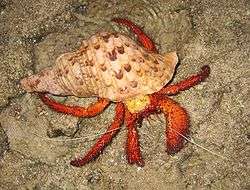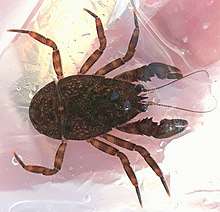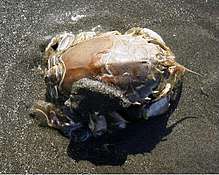Anomura
Anomura (sometimes Anomala) is a group of decapod crustaceans, including hermit crabs and others. Although the names of many anomurans include the word crab, all true crabs are in the sister group to the Anomura, the Brachyura (the two groups together form the clade Meiura).[1]
| Anomura | |
|---|---|
 | |
| The hermit crab Dardanus megistos | |
| Scientific classification | |
| Kingdom: | Animalia |
| Phylum: | Arthropoda |
| Subphylum: | Crustacea |
| Class: | Malacostraca |
| Order: | Decapoda |
| Suborder: | Pleocyemata |
| Infraorder: | Anomura Macleay, 1838 |
| Superfamilies | |
Description
The name Anomura derives from an old classification in which reptant decapods were divided into Macrura (long-tailed), Brachyura (short-tailed) and Anomura (differently-tailed). The alternative name Anomala reflects the unusual variety of forms in this group; whereas all crabs share some obvious similarities, the various groups of anomurans are quite dissimilar.[2]
The group has been moulded by several instances of carcinisation – the development of a crab-like body form.[3] Thus, the king crabs (Lithodidae), porcelain crabs (Porcellanidae) and hairy stone crab (Lomisidae) are all separate instances of carcinisation.[3]
As decapods (meaning ten-legged), anomurans have ten pereiopods, but the last pair of these is reduced in size, and often hidden inside the gill chamber (under the carapace) to be used for cleaning the gills.[4][2] Since this arrangement is very rare in true crabs (for example, the small family Hexapodidae),[5] a "crab" with only eight visible pereiopods is generally an anomuran.[2]
There is wide acceptance from morphological and molecular data that Anomura and Brachyura (true crabs) are sister taxa, together making up the clade Meiura.[3]
Classification
The infraorder Anomura contained seven extant superfamilies:[6][7][8][9]
| Superfamily | Members | Families | Photo |
|---|---|---|---|
| Aegloidea | Aegla | Aeglidae |  Aegla sp. |
| Chirostyloidea | squat lobsters | Chirostylidae Eumunididae Kiwaidae |  Eumunida picta |
| † Eocarcinoidea | † Eocarcinus † Platykotta | † Eocarcinidae † Platykottidae | |
| Galatheoidea | squat lobsters porcelain crabs | Galatheidae Munididae Munidopsidae Porcellanidae † Retrorsichelidae |  Munidopsis serricornis (Munidopsidae) |
| Hippoidea | mole crabs or sand crabs | Albuneidae Blepharipodidae Hippidae |  Blepharipoda occidentalis (Blepharipodidae) |
| Lithodoidea | king crabs | Hapalogastridae Lithodidae | Lithodes santolla (Lithodidae) |
| Lomisoidea | hairy stone crab | Lomisidae | |
| Paguroidea | hermit crabs coconut crab | Coenobitidae Diogenidae Paguridae Parapaguridae Parapylochelidae Pylochelidae Pylojacquesidae | Coenobita clypeatus (Coenobitidae) |
The oldest fossil attributed to Anomura is Platykotta, from the Norian–Rhaetian (Late Triassic) Period in the United Arab Emirates.[7]
References
- Gerhard Scholtz; Stefan Richter (1995). "Phylogenetic systematics of the reptantian Decapoda (Crustacea, Malacostraca)" (PDF). Zoological Journal of the Linnean Society. 113 (3): 289–328. doi:10.1111/j.1096-3642.1995.tb00936.x.
- Gary Poore (2004). "Anomura – hermit crabs, porcelain crabs and squat lobsters". Marine Decapod Crustacea of Southern Australia: a Guide to Identification. CSIRO Publishing. pp. 215–287. ISBN 978-0-643-09925-8.
- Shane T. Ahyong; Kareen E. Schnabel; Elizabeth W. Maas (2009). "Anomuran phylogeny: new insights from molecular data". In Joel W. Martin; Keith A. Crandall; Darryl L. Felder (eds.). Decapod Crustacean Phylogenetics. Crustacean issues. 18. CRC Press. pp. 399–414. doi:10.1201/9781420092592-c20. ISBN 978-1-4200-9258-5.
- Jonas Keiler; Stefan Richter (2011). "Morphological diversity of setae on the grooming legs in Anomala (Decapoda: Reptantia) revealed by scanning electron microscopy". Zoologischer Anzeiger. 250 (4): 343–366. doi:10.1016/j.jcz.2011.04.004.
- Carrie E. Schweitzer; Rodney M. Feldmann (2001). "Differentiation of the fossil Hexapodidae Miers, 1886 (Decapoda: Brachyura) from similar forms" (PDF). Journal of Paleontology. 75 (2): 330–345. doi:10.1666/0022-3360(2001)075<0330:DOTFHM>2.0.CO;2.
- Sammy De Grave; N. Dean Pentcheff; Shane T. Ahyong; et al. (2009). "A classification of living and fossil genera of decapod crustaceans" (PDF). Raffles Bulletin of Zoology. Suppl. 21: 1–109.
- Jérôme Chablais; Rodney M. Feldmann; Carrie E. Schweitzer (2011). "A new Triassic decapod, Platykotta akaina, from the Arabian shelf of the northern United Arab Emirates: earliest occurrence of the Anomura" (PDF). Paläontologische Zeitschrift. 85: 93–102. doi:10.1007/s12542-010-0080-y.
- K. E. Schnabel; S. T. Ahyong; E. W. Maas (2011). "Galatheoidea are not monophyletic – molecular and morphological phylogeny of the squat lobsters (Decapoda: Anomura) with recognition of a new superfamily". Molecular Phylogenetics and Evolution. 58 (2): 157–168. doi:10.1016/j.ympev.2010.11.011. PMID 21095236.
- WoRMS (2018). "Anomura". WoRMS. World Register of Marine Species. Retrieved 2018-09-28.